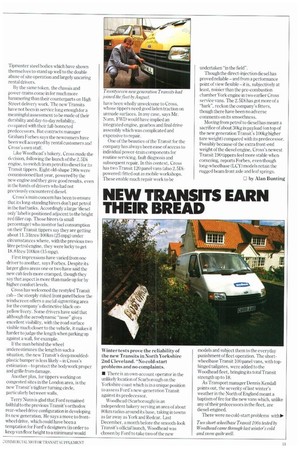UNIVERSAL TRANSPORT
Page 110

Page 111

If you've noticed an error in this article please click here to report it so we can fix it.
From spot-hire tipper rental to multi-drop delivery work, the new Transit has met operator expectations.
ACCEPTED BYALL
Seventeen years ago Cross chose the Transit as the backbone of its fleet. Today around 75 Transit tippers are operated.
• Self-drive tipper rental is a business into which many companies have ventured. One of the first on the scene and one of the few to survive and thrive is West London-based Cross Rent-a-Tipper, whose operations began back in 1969 when Harold Cross bought half a dozen 1.75 tonne payload Ford Transits with steel dropside tipper bodies and electro-hydraulic tipping gear with frontend rams.
Cross's initial choice of equipment has withstood the test of time. Seventeen years on, Transits still account for the vast majority of 3.5 tonnes GVW tippers in the Cross fleet.
Growth in the contract hire sector, particularly over the last three years, has reduced the percentage of 3. 5tonners on hire from Cross, as today's managing director Terry Nunn explains. '['he Transit's strength is on the spot rental side where builders, contractors and in particular local authorities want small tippers, often for a day or a week at a time, though in many instances longer.
Currently around 75 Transit tippers are being run by Cross, of which approximately a third are on contract hire, invariably finished in the customer's livery.
New-generation Transits are now entering service quite quickly with Cross —27 had been delivered by August. They are all 2. 5Di diesel-engined 190 chassis-cabs which, like their old-st yle Transit 190 predecessors, have Tipmaster steel bodies which have shown themselves to stand up well to the double abuse of site operation and largely uncaring rental drivers.
By the same token, the chassis and power-trains come in for much more hammering than their counterparts on High Street delivery work. The new Transits have not been in service long enough for a meaningful assessment to be made of their durability and day-to-day reliability, compared with their full-bonneted predecessors. But contracts manager Graham Forbes says the newcomers have been well accepted by rental customers and Cross's own staff.
Like Woodhead's bakery. Cross made the decision, following the launch of the 2.50i engine, to switch from petrol to diesel for its Transit tippers. Eight old-shape 190s were commissioned last year, powered by the new engine and they gave good results, even in the hands of drivers who had not previously encountered diesel.
Cross's main concern has been to ensure that its long-standing hirers don't put petrol in the fuel tanks. Accordingly a large 'diesel only' label is positioned adjacent to the bright red filler cap. Those hirers (a small percentage) who monitor fuel consumption on their Transit tippers say they are getting about 11.3 litres1100km (25 mpg) under circumstances where, with the previous two litre petrol engine, they were lucky to get 18.8 litesi100km (15 mpg).
First impressions have varied from one driver to another, says Forbes. Despite its larger glass areas one or two have said the new cab feels more cramped, though they say that aspect is more than made up for by higher comfort levels, Cross has welcomed the restyled Transit cab — the steeply-raked front panel below the windscreen offers a useful signwriting area for the company's distinctive black-onyellow livery. Some drivers have said that although the aerodynamic "nose" gives excellent visibility, with the road surface visible much closer to the vehicle, it makes it harder to judge the length when parking up against a wall, for example.
If the man behind the wheel underestimates the length in such a situation, the new Transit's deep mouldedplastic bumper is less likely — in Cross's estimation — to protect the bodywork proper and grille from damage.
Another plus, for tippers working on congested sites in the London area, is the new Transit's tighter turning circle, particularly between walls.
Terry Nunn is glad that Ford remained faithful to the previous Transit's orthodox rear-wheel drive configuration in developing its new generation. He says a move to frontwheel drive, which could have been a temptation for Ford's designers (in order to keep van floor height to a minimum) would Twentyseven new generation Transits had joined the fleet by August.
have been wholly unwelcome to Cross, whose tippers need good laden traction on unmade surfaces. In any case, says Mr. Nunn, FWD would have implied an integrated engine, gearbox and final drive assembly which was complicated and expensive to repair.
One of the beauties of the Transit for the company has always been ease of access to individual power-train components for routine servicing, fault diagnosis and subsequent repair. In this context, Cross has two Transit 120 panel vans (also 2. 5Dipowered) fitted out as mobile workshops. These enable much repair work to be undertaken "in the field".
Though the direct-injection diesel has proved reliable— and from a performance point of view flexible — it is, subjectively at least, noisier than the pre-combustion chamber York engine in two earlier Cross service vans. The 2.5Di has got more of a "bark", reckon the company's fitters, though there have been no adverse comments on its smoothness.
Moving from petrol to diesel has meant a sacrifice of about 30kg in payload (on top of the new generation Transit's 100kg higher tare weight) compared with its predecessor. Possibly because of the extra front-end weight of the diesel engine, Cross's newest Transit 190 tippers feel more stable when cornering, reports Forbes, even though long-wheelbase (LCY) models retain the rugged beam front axle and leaf springs.
0 by Alan Bunting
























































































































